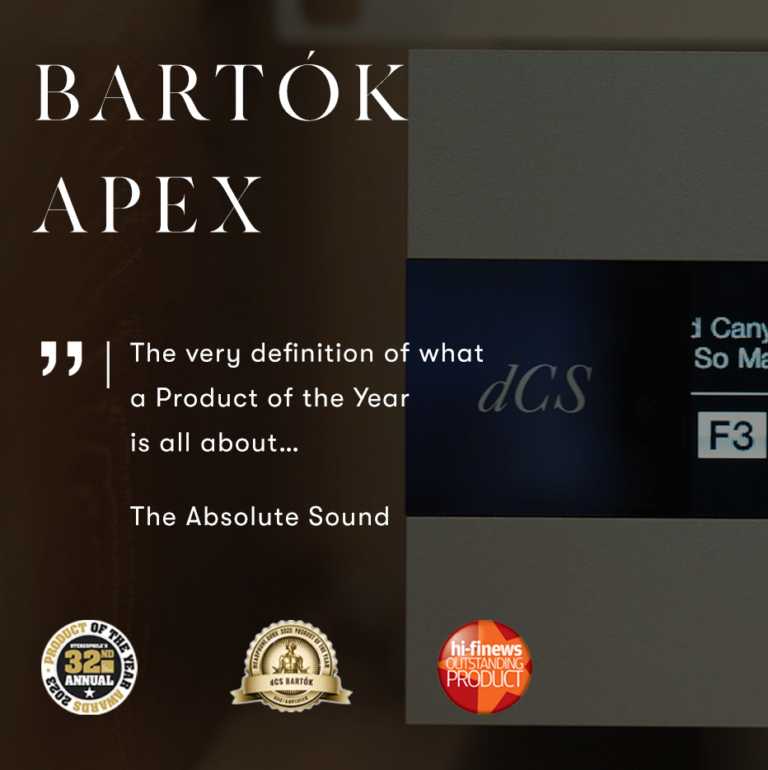dCS Bartok Apex DAC
Bartók APEX represents 30 years of innovation in one beautiful, flexible and future-proof chassis that embodies the essence of dCS.
Combining DAC, Music Streamer, Sampler, Pre-Amplifier and (optional) Headphone Amplifier, Bartók APEX delivers an unparalleled experience for headphone and stereo listeners. Now we’ve redefined the cutting edge of digital audio once again with our next-generation DAC hardware, the APEX Ring DAC. This upgrade allows us to take Bartók’s world-leading measured performance to a new level, technology that enables an even more immersive musical experience

- Latest-generation dCS Digital Processing Platform brings cutting-edge signal processing and flexibility
- Equipped with dCS Ring DAC™ as used in the dCS Vivaldi digital playback system
- Stream high-quality music from TIDAL, Qobuz, Deezer and internet radio via the dCS Mosaic Control app
- Roon Ready, AirPlay, Spotify Connect and UPnP compatible
- USB, AES, Dual AES and S/PDIF digital audio inputs
- Headphone amplifier with balanced and unbalanced outputs, suitable for high and low impedance headphones (Bartok model with headphone output only)
- Accepts encrypted SACD data from dCS Transport via dual AES ports. Oversampling design with switchable DSD sampling; user-selectable PCM and DSD filters
- Multi-stage DXD upsampling design with switchable DSD sampling; user-selectable PCM and DSD filters
- Automatic time locking improves ease of use and minimizes digital jitter
- Multistage power regulation and twin mains transformers to isolate the DAC section from the headphone amplifier (only on Bartok model with headphone output)
- Firmware upgradeable for future functionality and performance upgrades
|
Type |
Upsampling Network DAC with Headphone Amplifier |
|
Colour |
Silver or Black |
|
Dimensions |
444mm / 17.5” x 430mm / 17.0” x 115mm / 4.6“. Allow extra depth for cable connectors |
|
Weight |
16.7kg / 36.8lbs |
|
Converter Type |
dCS proprietary Ring DAC™ topology |
|
Digital Inputs |
Ethernet network port on RJ45 connector, accepts 24-bit 44.1 – 384kS/s PCM, DSD/64 & DSD128 in DFF/DSF format; USB 2.0 interface on B-type connector, accepts 24-bit 44.1 – 384kS/s PCM, DSD/64 & DSD128 in DoP format; USB On-The-Go interface on A-type connector, accepts 24-bit 44.1 – 384kS/s PCM, DSD/64 & DSD128 in DFF/DSF format; 2 x AES/EBU inputs on 3-pin female XLR connectors, accepts 24-bit 44.1 – 192kS/s PCM, DSD/64 & DSD/128 in DoP format; 1 x Dual AES pair, accepts 24-bit 88.2 – 384kS/s PCM, DSD/64 & DSD/128 in DoP format; 1 x SPDIF on RCA Phono connector, accepts 24-bit 44.1 – 192kS/s PCM & DSD/64 in DoP format; 1 x SPDIF on BNC connector, accepts 24-bit 44.1 – 192kS/s PCM & DSD/64 in DoP format; 1 x SPDIF optical on TOSLINK connector, accepts 24-bit 44.1 – 96kS/s PCM |
|
Analogue Outputs |
1 x pair balanced outputs on 2 x XLR connectors. Output levels: 0.2V, 0.6V, 2V, 6V rms for a full-scale input, set in the menu. Output impedance: 3Ω. Maximum load: 600Ω (10k-100kΩ is recommended); 1 x pair unbalanced outputs on 2 x RCA connectors. Output levels: 0.2V, 0.6V, 2V, 6V rms for a full-scale input, set in the menu. Output impedance: 52Ω. Maximum load: 600Ω (10k-100kΩ is recommended) |
|
Headphone Outputs |
1 x stereo balanced output 4-pin male XLR connector; 1 x stereo unbalanced output on 6.35mm (1/4”) 3-pole jack. Full-scale output levels: 1.4W rms into 33Ω, 0.15W rms into 300Ω. Minimum headphone impedance: 33Ω |
|
Wordclock I/O |
2 x Word Clock Inputs on 2 x BNC connectors, accept standard Word Clock at 44.1, 48, 88.2, 96, 176.4 or 192kHz. The data rate can be the same as the clock rate or an exact multiple of the clock rate. Sensitive to TTL levels. 1 x Word Clock Output on 1x BNC connector. With Sync Mode set to Master, a TTL-compatible Word Clock is output |
|
MQA |
Full decoding and rendering of MQA data from the Network and USB2 inputs. Final rendering of unfolded MQA data only from the other inputs |
|
Residual Noise |
24-bit data: Better than –113dB0, 20Hz – 20kHz unweighted (6V output setting) |
|
L R Crosstalk |
Better than -115dB0, 20Hz – 20kHz |
|
Spurious Responses |
Better than -105dB0, 20Hz – 20kHz |
|
Filters |
PCM mode: up to 6 filters give different trade-offs between the Nyquist image rejection and the phase response. DSD mode: 4 filters progressively reduce out-of-audio band noise level |
|
Conversions |
DXD as standard or optional DSD upsampling |
|
Software Updates |
Download and update functionality available via dCS Mosaic Control app |
|
Local Control |
dCS Mosaic Control app for unit configuration and playback. RS232 interface (controlled by a 3rd party automation system). dCS Universal Remote is available as an optional extra |
|
Power Supply |
Factory set to either 100, 115/120, 220 or 230/240V AC 50/60Hz |
|
Power Consumption |
30 Watts typical / 50 Watts maximum |

